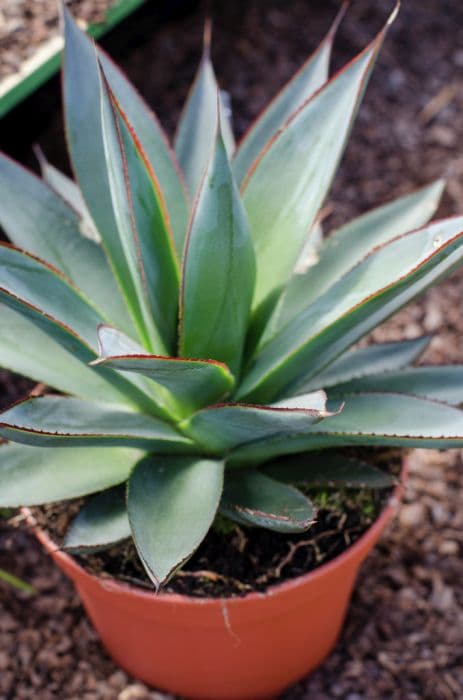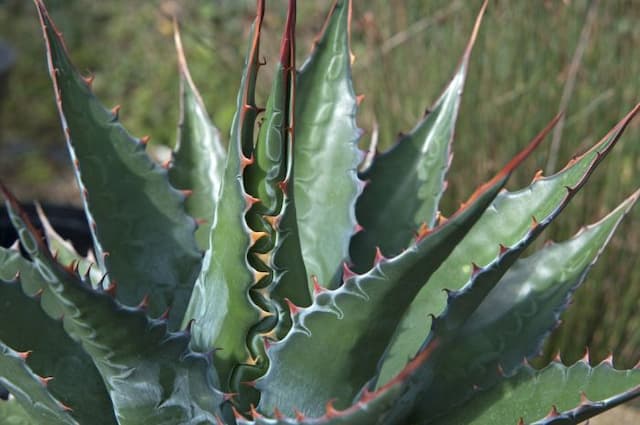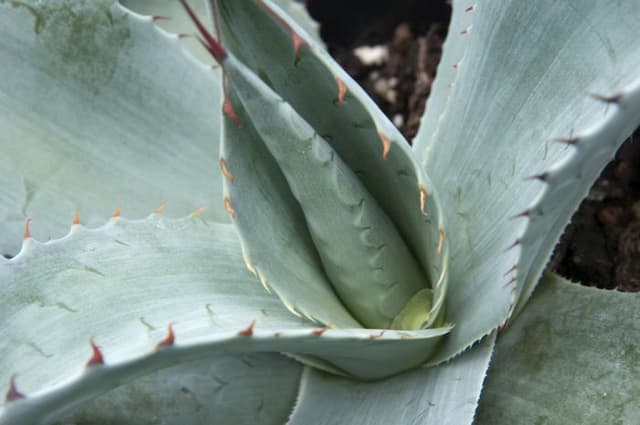Hyacinth Hyacinthus orientalis 'Ostara'

ABOUT
The Hyacinthus orientalis 'Ostara', commonly known as the common hyacinth, is a perennial plant well-loved for its vibrant and fragrant flowers. This variety dazzles with dense spikes of richly colored blooms that usually take on a deep blue or purplish hue. Each spike is crowded with numerous small, bell-shaped flowers that have a slightly recurved petal at the edges, providing a delicate and somewhat ruffled look. The blossoms are packed tightly together, creating a lush, columnar display of color. The leaves are equally as attractive, being glossy, strap-shaped and providing a striking dark green backdrop that amplifies the visual impact of the blooms. They emerge from the base of the plant and are fleshy, which complements the overall lush appearance of the common hyacinth. The foliage curves gracefully, framing the flowers and adding to the plant's overall elegance. Adding to its charm is the plant's fragrance, which is robust and sweet, capable of pervading the air around it and making it a favorite to plant near walkways and entrances where passersby can enjoy the scent. Given the proper care, the common hyacinth 'Ostara' is a classically beautiful plant that is synonymous with spring, bringing both color and fragrance to gardens and containers.
About this plant
 Names
NamesFamily
Asparagaceae
Synonyms
Common Hyacinth, Dutch Hyacinth, Garden Hyacinth, Oriental Hyacinth
Common names
Hyacinthus orientalis 'Ostara'.
 Toxicity
ToxicityTo humans
The common name for Hyacinthus orientalis 'Ostara' is hyacinth. Hyacinth bulbs contain oxalic acid and other alkaloid compounds that can be toxic if ingested by humans. If someone consumes any part of a hyacinth plant, they may experience symptoms such as intense nausea, vomiting, diarrhea, and can lead to severe dehydration if left untreated. Handling the plant, particularly the bulbs, may also cause mild skin irritation or allergic reactions for sensitive individuals. Ingestion of large quantities can potentially lead to more severe symptoms and medical attention should be sought immediately.
To pets
The hyacinth is also toxic to pets such as cats and dogs. Similar to its effects on humans, ingestion can lead to symptoms like vomiting, diarrhea, and excessive drooling. If a pet consumes a portion of a hyacinth plant, it can potentially result in irritation of the mouth and esophagus. Depending on the amount ingested, symptoms could escalate to an increased heart rate, difficulty breathing, and can be potentially fatal if enough of the plant is consumed. Immediate veterinary care is advised if a pet is suspected of ingesting hyacinth.
 Characteristics
CharacteristicsLife cycle
Perennials
Foliage type
Deciduous
Color of leaves
Green
Flower color
Purple
Height
0.5 feet (15 cm)
Spread
0.5 feet (15 cm)
Plant type
Bulb
Hardiness zones
4
Native area
Mediterranean
Benefits
 General Benefits
General Benefits- Attractive Fragrance: The Common Hyacinth 'Ostara' emits a strong and pleasant scent that can enhance the sensory experience of a garden.
- Spring Blossoms: This plant blooms in early spring, offering a vibrant display of colors after the winter months.
- Landscape Beautification: With its lush flowers and striking colors, the Common Hyacinth can beautify gardens, patios, and landscapes.
- Pollinator Friendly: It attracts pollinators like bees, which are crucial for the pollination of many other plants.
- Easy to Grow: The Common Hyacinth is considered easy to cultivate, making it suitable for gardeners of various skill levels.
- Container Gardening: It is well-suited for container gardening, allowing those with limited space to enjoy its beauty.
- Forcing Ability: The bulbs can be forced indoors during winter for an early bloom, providing flowers out of season.
- Symbolic Flower: It has cultural significance in many societies, often symbolizing peace and commitment, and is used in festive occasions.
- Decorative Cut Flowers: The flowers are long-lasting when cut and can be used in floral arrangements and bouquets.
- Variety of Uses: Common Hyacinth is versatile and can be used in beds, borders, rock gardens, and as under-plantings for shrubs and trees.
 Medical Properties
Medical PropertiesThis plant is not used for medical purposes.
 Air-purifying Qualities
Air-purifying QualitiesThis plant is not specifically known for air purifying qualities.
 Other Uses
Other Uses- As a natural dye: The flowers of the Hyacinth can be used to create a natural dye for fabrics, offering a range of purplish-blue shades.
- In perfumery: Due to its strong fragrance, Hyacinth essence is sometimes used in the production of high-end perfumes and scented oils.
- In the production of essential oils: The Hyacinth flower is used in making floral-scented essential oils, which are often utilized in aromatherapy.
- As a muse for artists: The striking appearance of the Hyacinth has inspired many artists, serving as a subject in paintings and floral arrangements.
- In culinary experiments: Although not widely used and requiring caution, some cultures incorporate Hyacinth petals in small amounts for their color and flavor in gourmet dishes.
- For educational purposes: The Hyacinth can be used in botany classes to illustrate bulb growth and flower development, providing a practical, hands-on learning experience.
- As a tool for learning about pollinators: The Hyacinth, being attractive to bees, can be used in gardens designed to study and support pollinator activity.
- In memory gardens: The Hyacinth is often planted in remembrance gardens due to the strong associative memory the scent of the flowers can evoke.
- In climate change studies: As a spring-blooming flower, the blooming period of Hyacinths can be an indicator of climate changes and global warming effects.
- For crafting: The dried flowers of Hyacinth can be used in potpourri or to create natural decorations and wreaths.
Interesting Facts
 Feng Shui
Feng ShuiThe Hyacinth is not used in Feng Shui practice.
 Zodiac Sign Compitability
Zodiac Sign CompitabilityThe Hyacinth is not used in astrology practice.
 Plant Symbolism
Plant Symbolism- Rebirth: Named after the Greek god Hyacinth, which is associated with spring and renewal, the Hyacinth represents rejuvenation and the arrival of new beginnings.
- Constancy and Sincerity: Hyacinths, with their robust growth and vibrant blossoms, are seen as symbols of steadfastness and honesty in relationships.
- Beauty: With its striking and fragrant flowers, the Hyacinth is often associated with physical attractiveness and charm.
- Sport or Play: In the language of flowers, Hyacinths can represent playful joy, perhaps connected to the outdoor activities that emerge with spring.
- Sadness or Sorrow: While often positive, Hyacinths can also symbolize a deep sense of loss or apology, possibly originating from the tragic myth of Hyacinth.
- Jealousy: Some interpretations of floriography attribute jealousy to the Hyacinth, perhaps linked to the god Apollo's envy in the ancient story.
 Water
WaterHyacinth bulbs, including the 'Ostara' variety, should be watered generously upon planting and then moderately as the plant grows. The soil should be kept moist but not waterlogged. Typically, watering once a week with approximately 16 ounces of water per bulb is sufficient; however, this may vary based on your climate and the soil moisture levels. During active growth periods in the spring, you may need to water more frequently to maintain consistent moisture. After the blooming period, reduce watering as the foliage begins to die back.
 Light
LightHyacinths like 'Ostara' require bright, indirect sunlight to thrive. They do best in a spot that receives morning sunlight and afternoon shade, particularly in areas with hot afternoons. Placing them near a south or east-facing window inside the home is ideal for the right balance of light. They can also be grown outside in well-lit areas but should be protected from intense midday sun.
 Temperature
TemperatureFor the 'Ostara' hyacinth, the ideal temperature range is between 60 and 70 degrees Fahrenheit. They can tolerate temperatures as low as 20 degrees Fahrenheit and can survive brief periods of colder temperatures, but they should not be subjected to hard freezes. The bulbs prefer cooler temperatures before they start growing, which stimulates blooming.
 Pruning
PruningPruning 'Ostara' hyacinths is typically done after the flowers have faded. Trim the flower stalks to prevent the plant from expending energy on seed production, but leave the foliage to continue photosynthesis and gather energy for the next year's growth. Cut back the leaves only after they have yellowed and died down naturally, usually several weeks after blooming.
 Cleaning
CleaningAs needed
 Soil
SoilThe best soil mix for Hyacinth (Hyacinthus orientalis 'Ostara') is well-draining, fertile loam with a pH of 6.5-7.0. Incorporate organic matter, like compost or well-rotted manure, to provide nutrients.
 Repotting
RepottingHyacinths, including Hyacinthus orientalis 'Ostara', are typically grown from bulbs and don't require frequent repotting. They should be repotted after flowering if the bulbs are overcrowded, usually every 2-3 years.
 Humidity & Misting
Humidity & MistingHyacinths, like Hyacinthus orientalis 'Ostara', prefer average home humidity levels. They do not require high humidity and can thrive in typical indoor conditions.
 Suitable locations
Suitable locationsIndoor
Place in bright light, cool temperatures, and provide good air circulation.
Outdoor
Plant in fall, full sun to partial shade, in well-drained soil.
Hardiness zone
4-8 USDA
 Life cycle
Life cycleHyacinth 'Ostara', a perennial bulbous plant, begins its cycle by emerging from a dormant bulb in early spring, with leaves and a flower stalk growing from the basal plate. The plant blooms, producing fragrant flowers in dense racemes, typically a deep blue-purple hue. Following bloom, the plant's flowers wither, and it enters a foliage period where energy is transferred back to the bulb for the next season. The leaves eventually yellow and die back as the plant enters summer dormancy. During late summer or autumn, the bulb can be divided and replanted, if desired, to propagate new plants. The cycle repeats when cooler temperatures and shorter days trigger the new growth of leaves and flowers for the next spring.
 Propogation
PropogationPropogation time
Spring
Propogation: The common Hyacinth, specifically the Hyacinthus orientalis 'Ostara', is often propagated by dividing its bulb clusters, typically after the foliage has died back following the flowering season in late spring or early summer. This is the most popular method due to its simplicity and effectiveness. The bulbs naturally produce offsets, which are smaller bulbs that can be carefully separated from the mother bulb without damage. Once separated, the offsets can be replanted immediately in well-drained soil at a depth of approximately 4 inches (about 10 centimeters) and spaced 3 inches (approximately 7.5 centimeters) apart. The replanted offsets will then grow on their own, typically blooming the following spring. It is important to ensure that the soil is kept moderately moist, but not waterlogged to prevent rot. This method allows gardeners to rapidly increase their Hyacinth collection and ensure a vibrant display of blooms every year.









